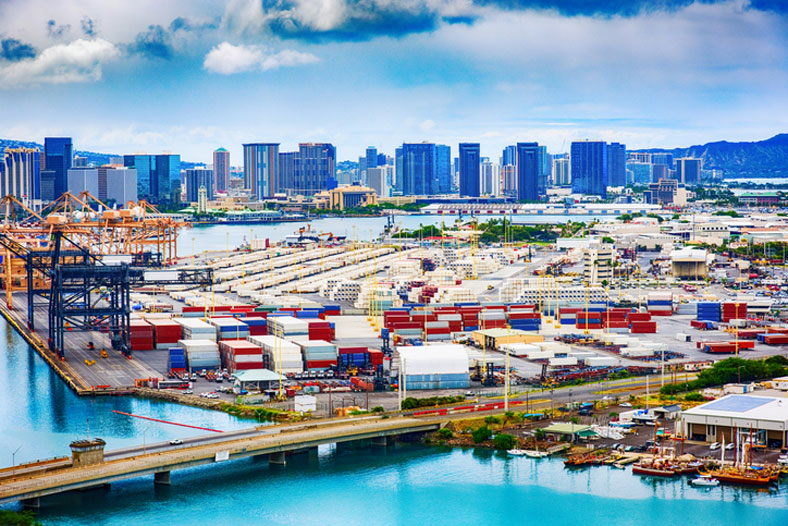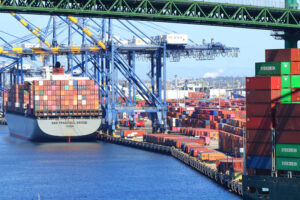
Long before the British Navy sailed the Seven Seas, ancient Hawaiians were traversing the Pacific in seafaring boats to trade and prosper, relying on their knowledge of currents and winds and navigating by the stars.
That proud legacy is alive and well today as shipping trade thrives across the islands. The state’s Harbor Division operates 10 commercial ports that see millions of tons of cargo transit through each year.
What isn’t shipped in by boat is flown in by plane. The Honolulu International Airport, operating flights to every major city on the Pacific Rim, is located just three miles away from one of America’s largest shipping container ports at the Honolulu Harbor.
From a logistics and supply chain perspective, Hawaii is in a uniquely advantageous position, situated between the world’s three largest economies. It’s one of the strongest states when it comes to having a robust tourist economy and service industry, and its climate makes it an agricultural powerhouse. Its geostrategic location also means plenty of federal investments to keep its defensive infrastructure primed.
All these natural advantages can go a long way towards underwriting prosperity, but they can also be squandered if not managed correctly.
This is where the skilled guidance of a supply chain management (SCM) team comes in. Virtually every company in Hawaii is dependent on a sea-based supply chain. That means they’re also dependent on supply chain managers with the kind of expertise you can only get with a degree in SCM.
Seaports – Hawaii’s Lifeblood
 It’s natural that a chain of islands would get a lot of their consumer goods via trans-oceanic shipping. Here in Hawaii, 85% of all goods are imported, and the vast majority of those –between 91% and 98.6%– are shipped in by boat. 15% of Hawaii’s imports are consumer goods, while the rest are raw materials.
It’s natural that a chain of islands would get a lot of their consumer goods via trans-oceanic shipping. Here in Hawaii, 85% of all goods are imported, and the vast majority of those –between 91% and 98.6%– are shipped in by boat. 15% of Hawaii’s imports are consumer goods, while the rest are raw materials.
The state’s 10 commercial ports are distributed throughout the islands, with three on Oahu, two on Kauai, two on the Big Island, and one each on Maui, Molokai, and Lanai.
Honolulu Harbor processes 12 million tons of cargo each year, making it by far the largest commercial seaport in the state and the 12th-busiest container port in the nation. It’s a natural 40-foot-deep harbor with 200 acres of container yard, 30 major berth facilities, and more than five miles of mooring space.
The Kalaeloa Barbers Point Harbor is also on Oahu and ranks as the state’s second-busiest port. Among its amenities are specialized cargo handlers like a pneumatic cement pump system and a coal bulk unloader.
Each year Hawaii imports around $2 billion-worth of goods, and outside of the mainland its largest import partner countries are Japan, South Korea, Russia, and China. By value its largest imports are:
- Oil and mineral fuels – $985 million
- Motor vehicles and parts – $184 million
- Furniture – $72 million
- Industrial machinery – $65 million
- Seafood – $52 million
But Hawaii’s seaports aren’t just for imports. Each year the state exports around $320 million-worth of goods, mostly to Australia, Japan, Bangladesh, Hong Kong, and South Korea. Its main exports are aircraft, iron and steel, seafood, beverages, and aluminum.
Hawaii’s economy, perhaps more than any other state’s, is critically dependent on efficient supply chains. That means being well-versed in SCM is always going to be an advantage no matter what line of work you’re in.
The subjects you’ll learn about in SCM undergraduate and graduate degree programs apply across the board and signal to LinkedIn scouts that you’re ready to be competitive in Hawaii’s unique marketplace.
What Does a Supply Chain Manager Do in Hawaii?
The principles you learn in an SCM program apply universally, no matter which of Hawaii’s many sectors you work in:
- Healthcare – Hawaii’s healthcare sector is one of the largest employers in the state and has unique supply chain demands. Major players include household names like Hawaii Pacific Health, Kaiser Permanente Hawaii, Hawaii Health Systems Corporation, and The Queen’s Health System.
- Ocean Logistics – One of the largest companies in Hawaii based on sales is Matson Inc., a leader in Pacific Shipping for over 100 years. It operates routes from Hawaii to Alaska, Guam, the South Pacific, and expedited freight transport between China and Southern California. Pasha Hawaii is another company that operates freight shipments between the mainland West Coast.
- Construction – It seems like everywhere you look in Honolulu you see construction cranes. Hawaiian Dredging Construction Company (HDCC), Nan Inc., Nordic PCL, and Albert C. Kobayashi (ACK) Inc. are all major players in this industry.
- Public Sector – Some of the largest employers in Hawaii are in the government sector. These include the City and County of Honolulu, the State of Hawaii, and the federal government at Joint Base Pearl Harbor-Hickam, Fort Shafter, and Marine Corps Base (MCB) Hawaii.
Browsing examples of SCM jobs is a good way to get a real-world feel for what’s involved in this career path.
It goes without saying that tourism is Hawaii’s cash cow, for better and for worse. To be a Catering and Supply Chain Operations Specialist with Hawaiian Airlines means duties like:
- Daily management of third-party logistics providers responsible for storage, shipping, and handling
- Reconciling inventory discrepancies to ensure daily, weekly, and long-term goals are met
- Maintaining good organization of all inventory-related paperwork and documents
To work in this position with Hawaiian Airlines, at minimum you must have a college degree or an equivalent number of years of experience, and two years of experience working with supply chains or related topics.
The State of Hawaii hires Procurement and Supply Specialists to ensure that all its departments on all islands are adequately provisioned to fulfill their mandates. This includes the state departments of Agriculture, Transportation, Legislature, Health, Human Services, and Education, to name just a few.
Naturally each department has its own unique supply chain demands which you’ll become familiar with as a Procurement and Supply Specialist. Duties associated with this position include:
- Developing specifications according to legal guidelines to offer project contracts up for public bidding
- Coordinating the purchase, storage, and transportation of supply chain materials for a specific state agency
- Being able to independently use modeling to analyze the supply chain and anticipate changes in demand
To work as a mid-level Procurement and Supply Specialist with the State of Hawaii you need at minimum a four-year bachelor’s degree, however it may be possible to substitute some experience in supply chain management for years of education.
Supply Chain Management Schools – Universities in Hawaii Offering Degrees in SCM Online and On-Campus
You can get a good sense of what SCM professionals do by looking at the topics introduced in an undergraduate degree program in supply chain management:
- Logistics and distribution management
- Business decision models
- Supply chain analytics
- Marketing channels
In SCM programs at the graduate level, you’ll encounter detailed coverage of advanced topics like:
- Sales and key account management
- Strategic international trade and logistics management
- Probability, statistics, and supply chain modeling
- Optimization techniques and integrated logistics systems
- Supply chain design and integration
In addition to aligning your career for upward mobility, a graduate degree in SCM is also a great tool if you’re a career changer looking to laterally transfer into this field.
Here we show all schools in Hawaii offering degrees in SCM at the undergraduate and graduate levels, both online and on-campus.
There are no listings at this time. Check back, as we update listings often.







